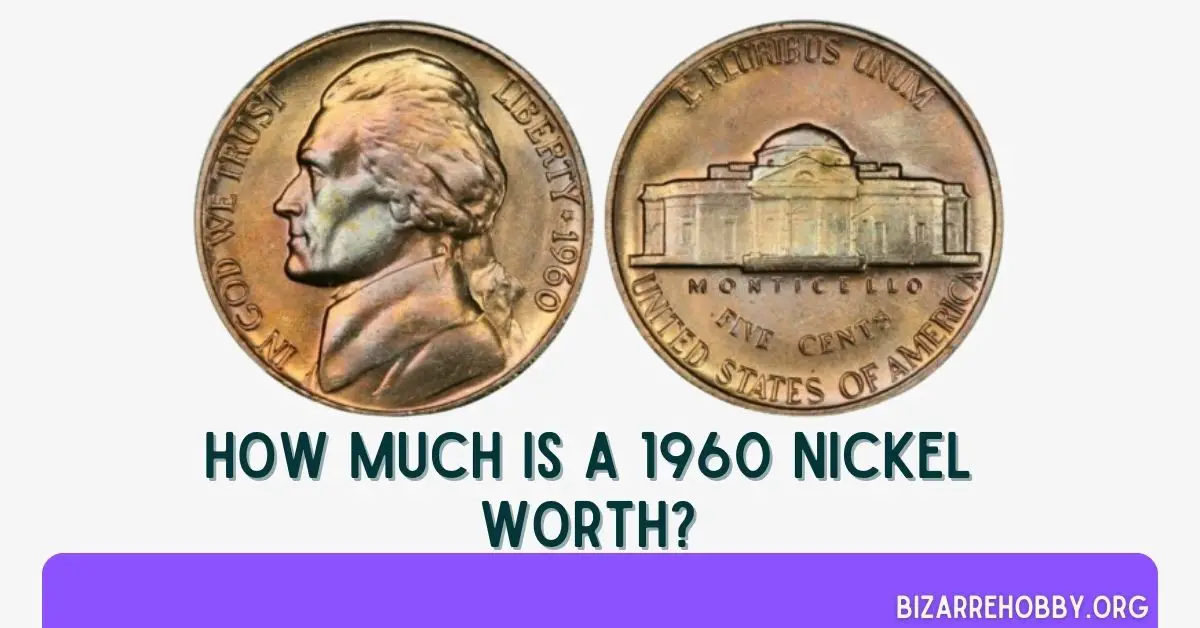The 1960 Jefferson nickel is a coin that holds a special place in the hearts of collectors. In this guide, we’ll delve into the value of the 1960 nickel and the factors that influence it. We’ll also explore some intriguing error coins that managed to slip past the Mint’s quality control. Additionally, we’ll take a journey through the history and design evolution of Jefferson nickels.
Excited to learn more? Let’s dive in!
Table of Contents
Value Charts for 1960 Nickel
| Mint Mark and Color | XF45 | MS60 | MS65 | MS67 |
|---|---|---|---|---|
| 1960 No Mint Mark Nickel Value | n/a | $2 Full step: $85 | $15 Full step: $3,150 | $2,500 |
| 1960 D Nickel Value | n/a | $2 Full step: $80 | $20 Full step: $3,150 | $4,150 |
| Mint Mark and Color | PR60 | PR65 | PR67 | PR69 |
|---|---|---|---|---|
| 1960 No Mint Mark Proof Nickel Value | $5 | $12 | $22 | $275 |
| Cameo: $10 | Cameo: $20 | Cameo: $46 | Cameo: $300 | |
| Deep Cameo: – | Deep cameo: $40 | Deep cameo: $85 | Deep cameo: $4,000 |
Historical Significance of the 1960 Nickel
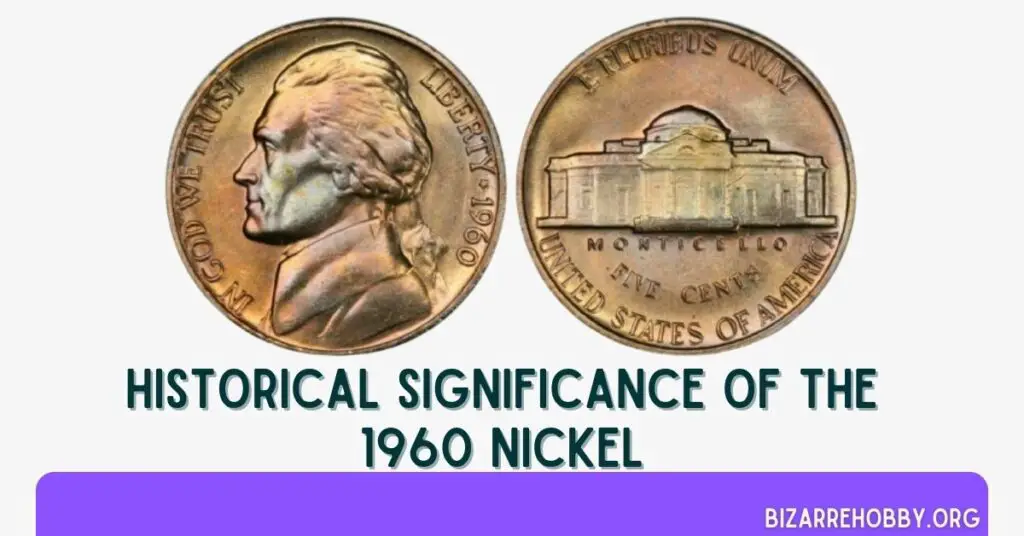
The 1960 nickel, known to collectors as the Jefferson nickel, carries a design that dates back to 1938. This series is named after Thomas Jefferson, whose portrait graces the obverse side of the coin.
Before the Jefferson nickel, the “Buffalo nickel” was in circulation, featuring an American bison on the reverse. Despite its popularity, the Buffalo nickel was challenging for the Mint to produce consistently, leading to its retirement after 25 years—the minimum period required before the Treasury could change a coin’s design without Congressional approval.
To find a new design, the Mint held a competition, which was won by German-born artist Felix Schlag. Schlag, who had emigrated to the United States in 1929 after serving in the German army during World War I, created the iconic Jefferson portrait. Initially, Schlag’s signature was absent from the coins, including those minted in 1960. However, in 1966, the US Mint invited him to add his initials to the design, which can be found at the base of Jefferson’s portrait.
In 2005, Schlag’s portrait was replaced by a new depiction of Jefferson, created by artist Jamie Franki.
The early Jefferson nickels were minted at three facilities: Philadelphia, San Francisco, and Denver. However, from 1954 to 1963, the San Francisco Mint ceased production, so no 1960 nickels bear the “S” mint mark. Proof nickels from 1960 were produced at the Philadelphia Mint and, like the business strike coins from the same facility, do not have a mint mark.
This historical context sets the stage for understanding the value and unique characteristics of the 1960 Jefferson nickel.
Design of the 1960 Nickel
The 1960 Jefferson nickel is a coin rich in history and design, making it a favorite among collectors. This coin not only carries the legacy of Thomas Jefferson but also showcases the artistry and craftsmanship of its time.
Obverse Design of 1960 Nickel
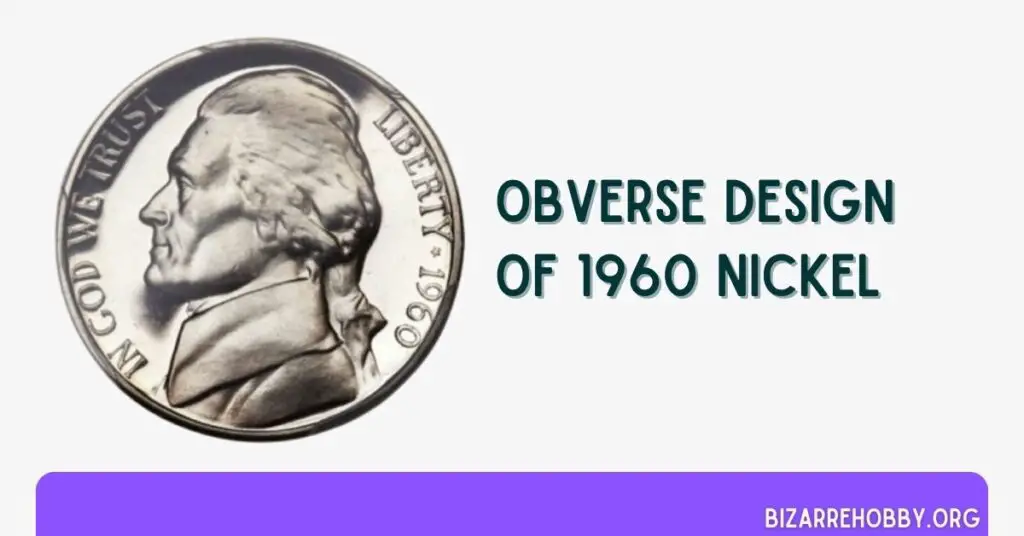
The obverse, or “heads” side, of the 1960 nickel features a profile portrait of Thomas Jefferson, the third President of the United States and a Founding Father. This design, created by Felix Schlag, depicts Jefferson with a subtle smile, a detail that adds a touch of personality to the coin. Schlag’s inspiration came from a bust by the renowned French sculptor Jean-Antoine Houdon, which can be viewed at the Boston Museum of Fine Arts.
To the left of Jefferson’s portrait is the inscription “IN GOD WE TRUST,” following the curve of the coin’s edge. On the right, the word “LIBERTY” is inscribed, followed by a star and the year “1960.”
Reverse Design of 1960 Nickel
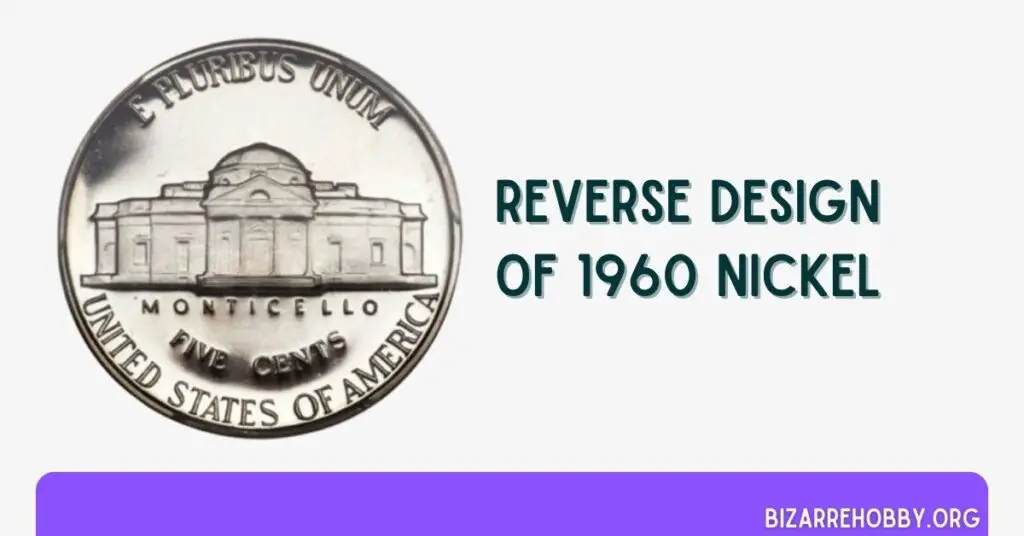
The reverse side of the 1960 nickel, also designed by Felix Schlag, features Monticello, Jefferson’s Virginia estate. Initially, Schlag’s design showed Monticello at an angle, but Treasury officials requested a frontal view, leading to the final design. Despite the changes, many coin historians prefer Schlag’s original angled depiction for its artistic flair.
Above Monticello, the Latin phrase “E PLURIBUS UNUM” curves along the top edge, translating to “Out of the many, one,” symbolizing the unity of the United States. Below the image, the denomination “FIVE CENTS” is inscribed, with “UNITED STATES OF AMERICA” curving along the bottom edge. Coins minted in Denver bear a small “D” to the lower right of Monticello, while those from Philadelphia have no mint mark.
Technical Specifications of 1960 Nickel
Jefferson nickels are primarily composed of copper, with nickel accounting for only a quarter of their weight, giving them their distinctive silver color. Each coin measures 21.2 millimeters in diameter and weighs 5 grams, with a plain edge.
1960 nickels are categorized into standard and “full step” nickels. The latter, which display all five steps of Monticello clearly, are particularly prized by collectors and can fetch a higher value.
Grading Guide for 1960 Nickel
Understanding the grading scale is crucial for determining the exact value of your 1960 nickel. Here’s a quick overview of the grading system:
| Sheldon Scale | Grade |
|---|---|
| 1 | Basal State-1 |
| 2 | Fair |
| 3 | Very Fair |
| 4, 5, 6 | Good |
| 7, 8, 10 | Very Good |
| 12, 15 | Fine |
| 20, 30 | Very Fine |
| 40 | Extremely Fine |
| 50 | About Uncirculated |
| 60 | Mint State |
| 65 | Mint State |
| 70 | Mint State |
Please refer to our detailed Jefferson Nickel grading guide to accurately assess your coin’s condition. This step is essential for determining its precise value.
1960 Nickel Value Guides
Determining the value of a 1960 nickel involves understanding its condition, mint mark, and any unique features or errors. Coins are graded on a scale from 1 to 70, with higher grades indicating better condition and higher value. Collectors particularly prize coins in mint state (MS) and those with full steps, which show all five steps of Monticello clearly.
1960 No Mint Mark Nickel Value

In 1960, the Philadelphia Mint produced over 55.4 million nickels, with approximately 44 million still in existence today. However, full step nickels are much rarer, with an estimated 9,500 surviving.
Coins graded from 1 to 59+ are circulated and show varying degrees of wear, while those graded 60 and above are uncirculated, known as “mint state.” Coins graded 65 and higher are considered “gems.”
A circulated 1960 no mint mark nickel typically holds only its face value due to its abundance. At MS60, these coins are valued at around $2. A gem MS65 is worth approximately $15, and an MS66 example can fetch around $32.
Top-grade coins, especially those with full steps, can be significantly more valuable. The finest standard 1960 nickels are graded MS67, with four coins certified at this level, each valued at $2,500.
Full step no mint mark nickels start at $85 at MS60, with a gem MS65 valued at $3,150. The highest graded full step 1960 (P) nickel, at MS66+, is worth an impressive $15,250.
1960 D Nickel Value
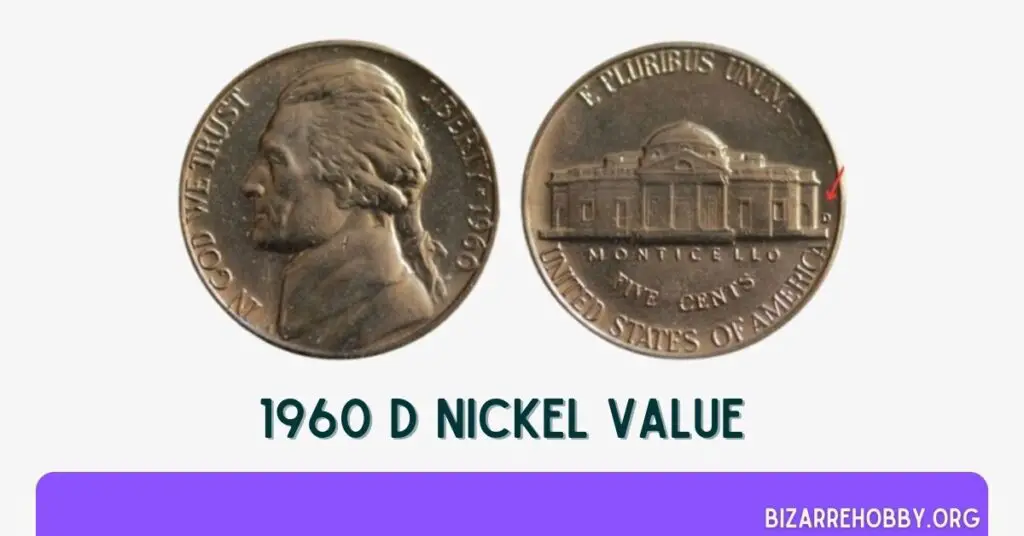
The Denver Mint struck 192.6 million nickels in 1960, identifiable by the small “D” on the reverse. Approximately 155 million of these coins survive today, mostly in circulated condition and worth only their face value.
Uncirculated standard coins start at a couple of dollars, but a gem MS65 can cost about ten times that amount. The finest standard 1960 D nickels, graded MS67, are valued at $4,150 each.
Interestingly, no 1960 D nickels have been found that meet the criteria for full step designation, indicating potential striking issues at the Denver Mint that year.
1960 No Mint Mark Proof Nickel Value

In addition to business strike coins, the Philadelphia Mint produced nearly 1.7 million proof nickels in 1960. These coins, struck on highly polished planchets with specially prepared dies, were primarily intended for collectors and archives.
Proof coins are uncirculated by definition and are graded with the prefix “PR.” Despite their attractive appearance, 1960 proof nickels are not as valuable as one might expect due to their careful storage by collectors. A PR60 proof nickel is worth around $5, doubling to $10 at PR65. Even a near-perfect PR69 proof is valued at about $275.
High-quality proofs with a strong contrast between polished fields and frosted devices are known as “cameos,” and those with especially dramatic contrast are “deep cameos.” Cameo proof nickels range from $50 at PR65 to $4,000 at PR69.
Rare 1960 Nickel Error List
Errors in coin production can make certain coins highly valuable and sought after by collectors. The 1960 Jefferson nickel is no exception, with several notable errors that significantly increase its worth.
1960 (P) No Mint Mark Nickel Struck on a 1-Cent Planchet Error

Occasionally, coins are mistakenly struck on the wrong planchet. One such error occurred with a 1960 nickel from the Philadelphia Mint, which was struck on a 1-cent planchet, giving it a distinctive copper color. This error coin, graded MS64 red and brown by the PCGS, fetched nearly $500 at auction due to its rarity and excellent condition.
1960 (P) No Mint Mark Proof Nickel Quadruple Die Reverse Error
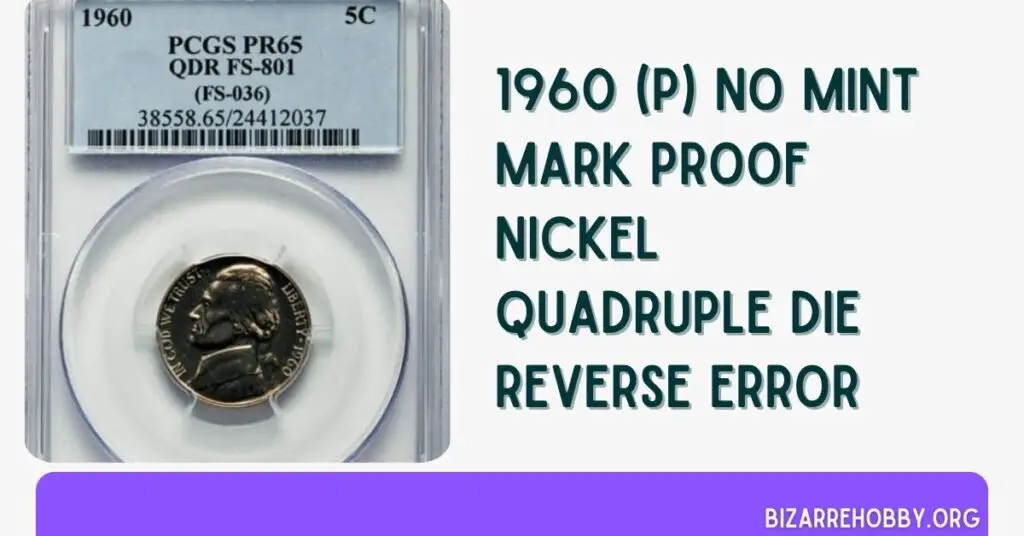
Errors can also occur during the die-making process, leading to fascinating variations. In 1960, a proof nickel from Philadelphia exhibited a quadruple die reverse (QDR) error. This happened when the hub and die were misaligned multiple times during the design transfer, resulting in parts of the reverse design appearing four times.
The value of these proof nickels varies with condition, ranging from $52 at PR60 to $240 at PR65. Cameo proofs with this error start at $100 for PR63, with the finest known example graded PR67+ estimated at $1,000.
Where to Sell Your 1960 Nickel?
Knowing the value of your 1960 nickel is just the first step. Selling it in the right place can help you get the best price. Here are some top online platforms to consider, each with its own pros and cons:
- eBay: Widely used and trusted, but fees can be high.
- Heritage Auctions: Great for rare and high-value coins, but the process can be lengthy.
- Coin Shows: Excellent for direct sales and networking, though not always convenient.
For a detailed comparison, check out our guide on the best places to sell coins online.
FAQs on 1960 Nickel Value
Are 1960 nickels silver?
No, the 1960 nickel is not made of silver. Its silver color comes from the nickel cladding, while the core is made of copper.
What to look for in a 1960 nickel?
The condition of the coin is crucial. Look for clear delineation of the steps in front of Monticello on the reverse side. A “full step” nickel, where all five steps are visible, is particularly valuable. Additionally, mint errors like those struck on the wrong planchet or with a quadruple die reverse can significantly increase a coin’s worth.
Final Thoughts
The 1960 Jefferson nickel is a fascinating piece of numismatic history, offering collectors a glimpse into mid-20th century coinage. Whether you’re interested in its historical context, unique design features, or the potential value of error coins, there’s much to appreciate.
Understanding the grading system and knowing where to sell your coins can help you maximize their value. Keep an eye out for those rare full step nickels and intriguing mint errors, as they can significantly enhance your collection
